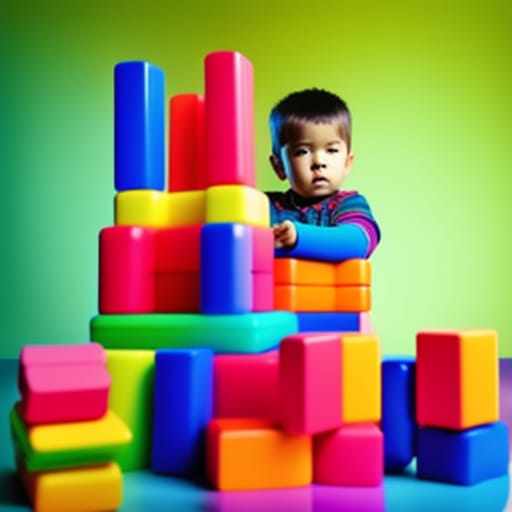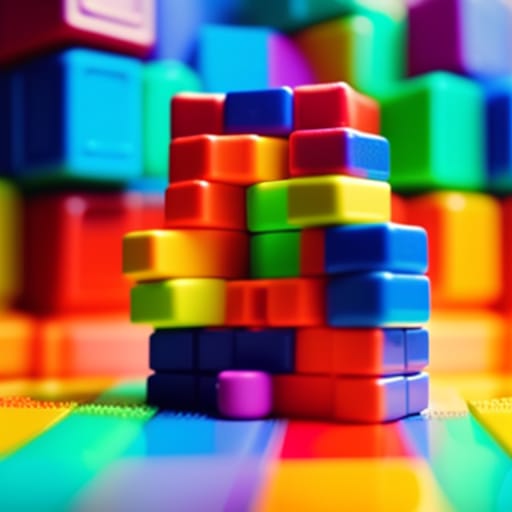Building blocks are a classic toy that has enthralled children for generations. More than just a fun playtime activity, building blocks offer a wealth of benefits for a child’s learning and development. This beginner’s guide will explore how simple blocks can build key skills.

An Introduction to Building Blocks
Building blocks are construction toys made up of interlocking pieces that can be assembled in various ways. Traditional wooden unit blocks have been popular since the 1800s. Today’s blocks come in a range of materials like plastic, foam, and cardboard. Sizes vary from large oversized blocks to small manipulative sets.
Building blocks allow children to explore concepts like:
- Spatial awareness
- Creativity
- Problem-solving
- Early math skills like counting, sorting, and patterns
- Fine motor control
- Visual perception
- Communication and social skills through collaborative play
Pediatricians and childhood development experts agree that playing with blocks offers important learning experiences that contribute to a child’s growth and prepare them for success in school.
Key Benefits of Building Blocks
Playing with building blocks offers a wealth of developmental and educational benefits:
Spatial Awareness
Stacking blocks helps children learn about shapes, sizes, balance, and position. As they experiment with building vertically and horizontally, they develop spatial reasoning skills. Important spatial vocabulary like up, down, over, under, next to, behind, in front of, above, and below are reinforced.
Creativity and Imagination
There is no “right” way to build with blocks – the possibilities are endless. Open-ended play encourages creativity as children build elaborate structures, vehicles, animals, and more. Making something unique boosts self-expression, imagination, and inventiveness.
Problem-Solving Abilities
Assessing how to construct sturdy structures that won’t topple over involves critical thinking, planning, and trial and error. Figuring out how blocks fit and work together in three dimensions utilizes key problem-solving skills.
Early Math Skills
Counting pieces, grouping blocks by color or shape, and recognizing patterns are the building blocks (pun intended!) for developing math abilities. Comparing heights and lengths of towers or recognizing shapes boosts knowledge of geometry and spatial relations.
Fine Motor Control
Picking up blocks and joining them together utilizes fine motor muscles in the hands and fingers. Building hand-eye coordination and dexterity prepares little hands for later writing and manipulation tasks.
Language Development
Describing what they are building encourages verbal skills. Block play sparks conversations that expand a child’s vocabulary. Listening to stories about their constructions also builds narrative abilities.
The collaborative building promotes important social and communication abilities like sharing, cooperation, turn-taking, and following instructions.
Getting Started: A Guide for Parents
Building blocks make an ideal toy for toddlers aged 1-3 years and remain engaging for kids up to age 7. Here are some tips for integrating blocks into playtime:
Select a Variety
Look for a starter set that offers an assortment of shapes like traditional squares and rectangles, as well as triangles, cylinders, arches, and more. Varying sizes from large to small blocks allow for more creative constructions.
Popular basic starter sets include:
- Melissa & Doug 60-Piece Standard Unit Blocks Set – high-quality solid wood blocks with colorful finishes for $30
- Hape Quadrilla Wooden Building Blocks – beech wood pieces in geometric shapes for $25
- LEGO Classic Large Creative Brick Box – vibrant colored plastic bricks in different sizes for $25
Encourage Open-Ended Play
Allow children to explore building on their own rather than following strict step-by-step instructions. Asking open-ended questions sparks imaginative play:
- What are you going to build today?
- How will you make your tower taller?
- What else could you make with these blocks?
- How can you make a road for your cars?
Avoid directing them toward a specific result. The journey of creating is more valuable than the final structure.
Add Supplemental Elements
Expand possibilities by providing additional accessories:
- People and animal figures: Bring structures to life with little residents
- Vehicles: Cars, trains, and planes can transport figures
- Natural elements: Rocks, sticks, and leaves can spark nature scenes
- Toy tools: Wrenches, hammers, and hard hats extend role playing
Encourage Collaboration
Building together lets children practice communication, sharing, and compromise. Guide interactions:
- Take turns adding blocks
- Build something based on each other’s ideas
- Make a creation with different responsibilities (one builds towers, one makes trees)
Store Creatively
Keep blocks accessible in baskets or cloth bags. Sorting trays let kids organize pieces by shape, color, or material. Building a special shelf at a child’s height encourages independent play.

Making Building Block Play Educational
Beyond open-ended construction, a few simple activities extend learning:
- Alphabet blocks: Build the first letter of the child’s name with examples (“B is for Brianna, bike, baby”)
- Math blocks: Count different colored blocks, identify shapes, and build AB patterns
- Storytelling: Construct scenes as you make up an imaginative tale together
- Spatial concepts: Use blocks to demonstrate positional words like above, below, beside, behind
Key Skills by Age
Tailor block play to your child’s developing abilities:
1 year olds: Stacking 2-3 blocks vertically
2 year olds: Building a small tower with different shapes
3 year olds: Bridging blocks to make a simple structure with an opening
4 year olds: Following visual patterns when stacking, sorting by shape or color
5 year olds: Planning and envisioning what to build before starting
6-7 year olds: Building elaborate structures with 20+ blocks
Top Educational Building Block Sets
Blocks designed for early learning have guided activities that build literacy, math, problem-solving and more.
- Hape Quadrilla Wooden Marble Run – build paths for marbles to roll down
- Learning Resources Gears! Gears! Gears! – connect moving plastic gears and cranks
- Tegu Magnetic Wooden Blocks – build imaginatively using magnetic pieces
- Grimm’s Wooden Rainbow Logic Stacker – stacking pieces correspond to color patterns
Fostering Development Through Building
Playing creatively with blocks provides a strong foundation across many domains:
- Cognitive skills: symbolic representation, spatial reasoning, cause and effect
- Language: vocabulary building, expression, comprehension
- Physical abilities: fine muscle control, coordination, balance
- Socio-emotional skills: sharing, cooperation, pride in achievements
Open-ended block play gives kids the freedom to experiment, test theories, and channel their imagination. Activities can be adapted across ages and skill levels making blocks the ultimate educational toy with unlimited possibilities.
So break out those old blocks collecting dust or invest in a new set! Unleashing your child’s inner architect will help build a lifetime of learning.

More Resources on Children’s Building Blocks
To learn more about the educational benefits of building blocks and finding the right sets for your child, check out these helpful websites:
NAEYC article on importance of block building
Growing Book by Book’s guide to the best building toys
How block play builds skills from Zero to Three
Guidance from Parents on getting started with blocks
Let the building begin!
Frequently Asked Questions
What are the best building blocks for a 2 year old?
For a 2 year old, choose larger-sized blocks in simple shapes like squares, rectangles, and triangles. Sets with 20-30 pieces in bright colors like the Melissa & Doug Standard Unit Blocks are ideal for introducing early construction play.
What skills do building blocks develop?
Building blocks help develop spatial awareness, math skills, hand-eye coordination, problem-solving, and language development. Concepts like shapes, colors, counting, positioning, balance, and motor control are built through block play.
How do I teach positional words with blocks?
Use blocks to demonstrate positional terms like “under, over, behind, next to, on top” as you build. Ask questions like “Can you place the red block under the blue block?” to reinforce spatial language.
What games can you play with building blocks?
Fun games with blocks include building towers and seeing who can stack highest before it topples, racing to construct a structure from a model, and storytelling by adding blocks as you make up an imaginative tale.
Are expensive building blocks worth it?
Pricier wooden and plastic blocks tend to be higher quality and last longer through rough play. Look for sets with variety in shape and size like Hape Quadrilla, Grimm’s Rainbow, or Tegu blocks. Higher costs can be worthwhile for toys that engage kids through early childhood.